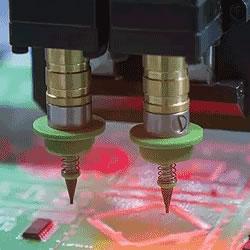ABB expands collaborative portfolio with the introduction of SafeMove2, its latest generation robot monitoring system
The new safety certified software delivers greater flexibility, space savings and cutting edge commissioning tools for greater productivity at a lower total investment cost.
AUBURN HILLS, Mich. (June 27, 2016) - ABB Robotics is pleased to announce the launch of SafeMove2, the latest generation of its safety certified robot monitoring software. SafeMove2 delivers greater flexibility, space savings and cutting edge commissioning tools for greater productivity at a lower total investment cost. This, combined with unsurpassed safety, enables closer collaboration between robots and factory workers.
Like the original SafeMove, first introduced in 2008, SafeMove2 includes a host of cutting-edge safety functions, including safe speed limits, safe standstill monitoring, safe axis ranges and position and orientation supervision. The new generation functionality encourages the development of innovative robot applications by integrating safety features directly into the robot controller.
"To be efficient, robots must be able to move at speeds suited to the given application. At high speeds this can present a potential hazard for people working in the immediate vicinity. Historically, fences or cages have been used to separate man from machine in an effort to keep them out of harms way," says Dr. Hui Zhang, Head of Product Management, ABB Robotics. "SafeMove2 allows robots and operators to work more closely together by restricting robot motion to precisely what is needed for a specific application."
SafeMove2 allows for the creation of more efficient and flexible production scenarios, and provides tools that speed the commissioning workflow for faster setup and validation. It also integrates safety fieldbus connectivity into ABBs IRC5 robot controller family as well as the IRC5 Single, Compact and Paint controllers.
With SafeMove2 the tools to facilitate collaboration between man and machine are a reality. For example, if an operator needs to interact with the robot system, safety sensors can be incorporated into the robot cell to detect the persons presence. After detected, SafeMove will either supervise the robots speed or monitor it while it is standing still. Once the person clears the zone, the robot can resume operation. The end result is less down time and increased productivity.
The efficiency and flexibility gained from enhanced collaboration solutions like SafeMove2 contribute to the integrated ecosystem which ABB calls the Internet of Things, Services and People. ABB Robotics continues reshaping the way the world looks at manufacturing automation with a number of innovative solutions and services that are helping its customers realize the benefits of the factory of the future, today.
--------------------------
About ABB
ABB (www.abb.com) is a leader in power and automation technologies that enable utility and industry customers to improve their performance while lowering environmental impact. The ABB Group of companies operates in around 100 countries and employs about 150,000 people.
About ABB Robotics
ABB Robotics (www.abb.com/robotics) is a leading supplier of industrial robots - also providing robot software, peripheral equipment, modular manufacturing cells and service for tasks such as welding, handling, assembly, painting and finishing, picking, packing, palletizing and machine tending. Key markets include automotive, plastics, metal fabrication, foundry, electronics, machine tools, pharmaceutical and food and beverage industries. A strong solutions focus helps manufacturers improve productivity, product quality and worker safety. ABB has installed more than 250,000 robots worldwide.
All ABB Robotics' products are fully supported by the ABB Robotics global sales and service organization in 53 countries and over 100 locations.
Featured Product

